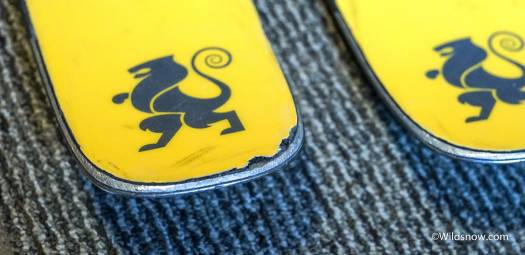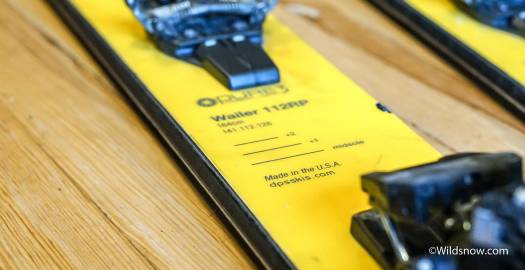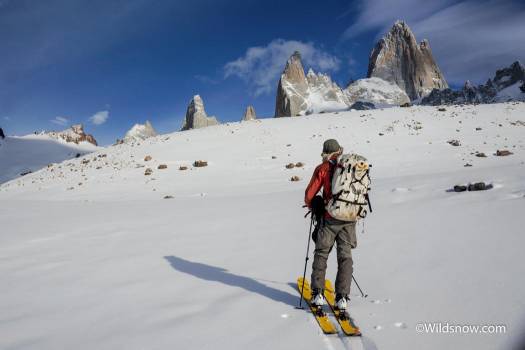
My Wailers have followed me on an enormous number of ski trips. This fall I took them down to South America. Between bushwhacking, ornery taxi drivers, thin snow cover, and a road trip down the Ruta 40, they saw some abuse and kept on truckin. The Wailers making a skin track below Fitz Roy, in southern Argentina. Click images to enlarge.
It’s often hard to find gear reviews where people have put a substantial amount of use on their gear before writing about it. However, long-term durability and quality is arguably one of the more important factors to look at when choosing some new gear. “Just pulled the jacket out of the mail and it looks great! Five stars!” doesn’t help much (and yes, we’ve been guilty of that).
It’s no secret that we like DPS skis here (along with the many among the powder-seeking masses). People often tell me they want a pair, but aren’t sure if they are worth the extra cash. Around $1300 dollars for a pair of skis is significant, especially if you’re a penny-pinching ski bum. However, if you’re buying a set to use for a few years, it might be worth it to pony up for membership in the Drake Powder Church. If that’s the plan, they need to hold up to years of hard use. Can they?
Unfortunately, light backcountry skis have traditionally been lacking when it comes to longevity and resisting wear and tear. Most of the techniques used by manufacturers to up the durability of their sticks involve thickening various parts, such as bases, edges, top-sheets, and sidewalls. Also, skis with lots of metal in their construction are known to be durable and have consistent flex over time. All of these methods add significant weight to a ski, and are often the first features to go when a company makes a lightweight backcountry ski.
DPS skis are known for their quality and light weight. I’ve had a pair of Wailer 112RPs since early last winter, and have been using them hard ever since. When I got them they were not new. They were a set of DPS demo sticks, and had made the rounds of various WildSnow testers before being screwed to my Dynafits. Since then, they’ve become my daily driver, following me on ski trips around the Cascades as well as around the world to Canada, South America, and Japan. It is safe to say they’ve had well over 200 days of skiing, along with lots of travel and bushwhacking (things not easy on skis). They are definitely showing their age, but have held up quite well.
The sidewalls and edges of the top-sheet are vulnerable places on a pair of skis. I’d say the Wailers are moderately durable in this regard. They have a hard top-sheet (especially compared to some skis, like K2s. A hard top-sheet has pros and cons. It’s resistant to scratching, but also a bit more brittle than other materials, and prone to cracking. I’ve got a few dings in my top-sheets, and there are a few small spots where some has broken off, exposing the next layer down. The sidewalls of the skis are about average durability, with a few dings and dents from various falls and rocks. However, one area that the DPS skis really stand out on is in the tip and tail. In later models (after 2013?) DPS added a chunk of thick aluminum to the tip and tail of their skis. This was done to make the tip and tail heavier in order to make them be more damp and ski better. It’s the opposite approach that many skis use, which is often to carve material out of the tip and tail to save weight. I’ve found the added weight makes them a bit more damp. The aluminum also makes the tip and tail mega-burly; I’ve abused them, hitting rocks, tree stumps, and truck beds. They’ve proven to be exponentially more durable than a traditional tip.
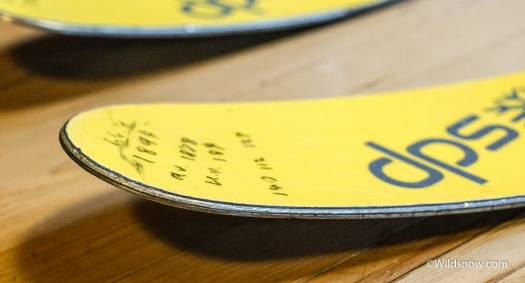
The unique metal construction of the Wailer’s tip. You can see it has had some abuse, but hasn’t seen any significant chipping or delamination.
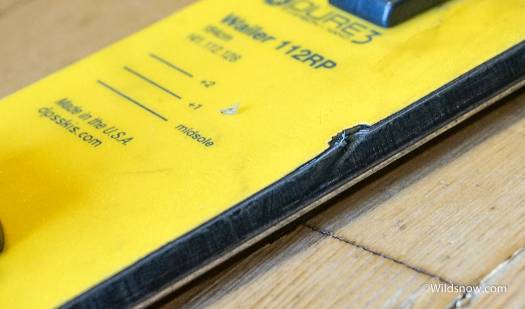
This ding is the only major damage the skis have sustained. It happened during a high-stakes somersault through Chilean underbrush. Although it’s a deep ding, it didn’t make it through the sidewall.
Many of my skis lose their flex after moderate use, especially the lightweight ones. Through my completely unscientific hand-flexing, the Wailers feel like they have a similar flex to when I first got them: moderately stiff.
I’m always skeptical of lightweight ski durability and longevity, but I’ve been pleasantly surprised by how the DPS ski has held up. It seems like a portion of the price tag goes into build quality and attention to detail.
Louie Dawson earned his Bachelor Degree in Industrial Design from Western Washington University in 2014. When he’s not skiing Mount Baker or somewhere equally as snowy, he’s thinking about new products to make ski mountaineering more fun and safe.

